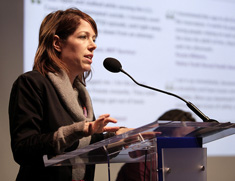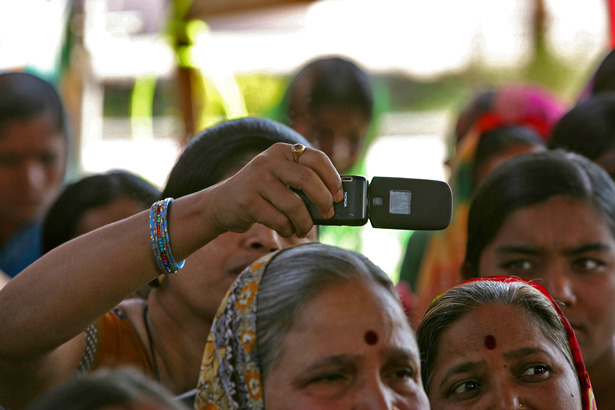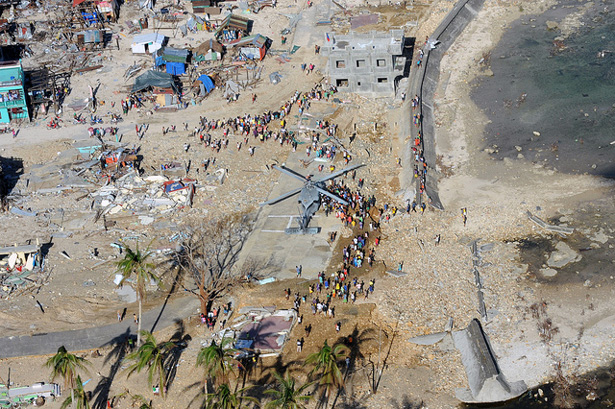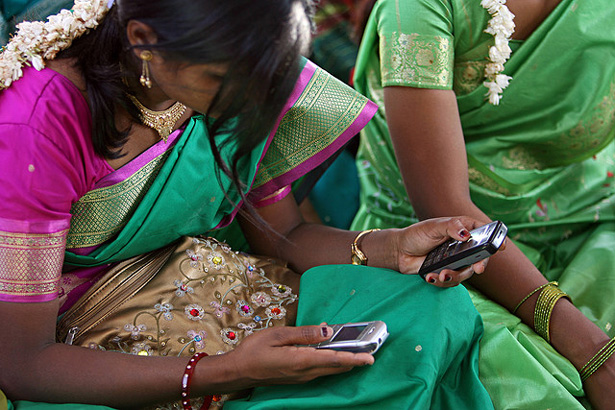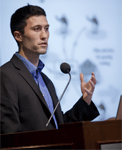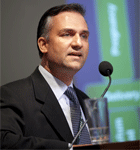-
Kathleen Mogelgaard, Aspen Institute
Hungry, Hot, and Crowded: The Importance of Multi-Dimensional Strategies for Resilience
›May 6, 2014 // By Wilson Center StaffIn a world faced with rising temperatures, increasingly severe droughts and floods, and a rapidly growing population, how can people adapt to this new way of life – and even thrive? Leading experts discussed this question in-depth during an Aspen Institute Global Health and Development Program event titled, “Building Resiliency: The Importance of Food Security and Population.” The panel took place as part of the Civil Society Policy Forum at the 2014 IMF/World Bank Spring Meetings in Washington, DC.
-
A New Model of Development? The Role of Public-Private Partnerships in International Aid
›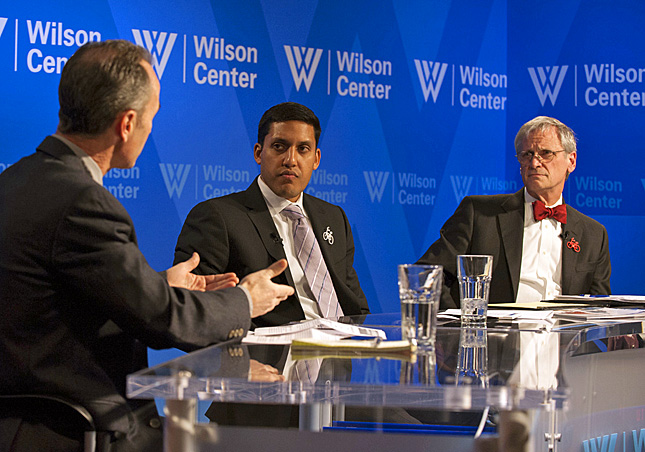
USAID funding is “far outstripped” by private investment and business relationships in “nearly every country” in which it works – and that’s a good thing, according to USAID Administrator Rajiv Shah. [Video Below]
-
Nancy Schwartzman on Fighting Rape Culture Worldwide With Emerging Social Technology
›
Sexual assault remains distressingly common throughout the world and too often it’s the victim who gets the blame, says Nancy Schwartzman, filmmaker and executive director of Tech 4 Good, in this week’s podcast.
-
Turning the Tide? Technology Provides New Ways to Combat Gender-Based Violence
›
Worldwide, one in three women suffer beatings, coercion into sex, or other abuse from an intimate partner during her lifetime, according to the UN, while one in five is a victim of rape or attempted rape.
“Gender-based violence is a pervasive global challenge. It serves as a barrier to national economic and social advancement across the world,” said Alex Dehgan, former chief scientist and director of the Office of Science and Technology at the U.S. Agency for International Development, on December 9 at the Wilson Center. [Video Below]
-
Beyond the Horizon: Understanding the Future for Better Development Today
›December 16, 2013 // By Kathleen Mogelgaard
When Super Typhoon Haiyan ripped through the Philippines last month, the incredible damage visited on the people, infrastructure, and land was shaped by trends that have been in motion for decades. The country’s population has been growing rapidly, with high concentrations of people living in cities and along the coast; economic growth had been steady, but weak governance and corruption may have exacerbated vulnerability; and the gradual loss of coastal forests and mangroves left many communities exposed to the full brunt of the typhoon’s storm surge. On a positive note, wireless technology and crowd-sourced data helped in disaster response.
-
Critical Mass? How the Mobile Revolution Could Help End Gender-Based Violence
›
The past three years – and more pointedly the past 12 months – have laid witness to monumental, if not heartbreaking, incidents of gender-based violence. The gang rape of a 23-year-old woman in New Delhi last December; the gang rape of a 16-year-old girl left for dead in a pit latrine in Western Kenya last June; the mass sexual assault of women in Tahrir Square during the 2011 revolution in Egypt and since; all were high profile atrocities that ignited outrage around the world.
-
Mobile Phones for Maternal Health in the Developing World
›With rising use in the developing world, cell phones and mobile technologies can create “connected and coordinated health systems that save more lives,” said Josh Nesbit at the GHI event “New Applications for Existing Technologies to Improve Maternal Health,” on October 27. Capitalizing on these new technologies could increase efficiency, cost-effectiveness, and efficacy of public health programs. Nesbit, executive director of FrontlineSMS: Medic, was joined by Alain Labrique, assistant professor at the Johns Hopkins School of Public Health, and David Aylward, executive director of the mHealth Alliance at the United Nations Foundation, to discuss the role of Information and Communication Technologies (ICTs) in the prevention of maternal mortality.
Collaborations for mHealth
While “cell phones can’t save lives, the lack of information does kill,” said Aylward. Using technology that many people already own and use, mobile technology is an appropriate tool for disseminating health data and information. Existing technologies such as mobile phones and SMS text messaging can revolutionize healthcare by improving data collection and disease tracking, expanding patient diagnostics, and advancing education and awareness among health workers and patients.
With 64 percent of all mobile phone users located in the developing world, the use of mobile devices to improve health services in low-income countries is especially promising.
Aylward hopes that mobile health technology (mHealth) will help combat maternal mortality in the developing world. With approximately 350,000 women dying in childbirth each year, and only marginal progresses towards achieving Millennium Development Goal 5, finding such innovative solutions to improve maternal health is crucial.
Public-private partnerships are particularly important when considering the long-term sustainability of mHealth programs. “This didn’t happen because of the World Bank, it happened because people who are very poor voted with their very limited funds to have access to information,” said Aylward.
Aylward is hopeful that government and donor support will continue to become more supportive of mobile technology and coordinated in their implementation of mHealth programs globally.
Mobile Health Solutions in the Developing World
“Through mobile tools, we can act as quickly as possible to improve access to skilled birth attendants, emergency obstetric care, and access to reproductive health commodities,” said Nesbit.
Nesbit’s organization, FrontlineSMS: Medic, is working to eliminate barriers created by the lack of resources and infrastructure in the developing world using mobile health technology. Now working in 20 countries, the organization uses free software “that enables large-scale, two-way text messaging using only a laptop, a GSM modem, and inexpensive cell phones,” explained Nesbit.
“One of the best measures is whether people continue to use your tools, and they will if it impacts their lives positively and they won’t if it doesn’t—sometimes it’s as simple as that,” said Nesbit on why communities in the developing world are eagerly embracing mobile technology.
Moving forward, Nesbit hopes to “scale and replicate, both vertically and horizontally, models that we’ve shown can work, but also to build new tools” and work with the health community “to help identify the needs and the gaps in these systems.”
However, Nesbit stresses that “these are very much tools and not solutions; they become solutions when they are paired with people on the ground who use them.”
Compressing the Time Between Crisis and Care
“The opportunities for mobile phones to act synergistically with existing health systems in low- to middle-income countries are many,” said Labrique. The current challenge is to harness this technology to improve health outcomes in the developing world, where disease burden is disproportionately high.
In the developing world, “decisions influenced by the lack of resources, such as poverty, or lack of information have led to highly convoluted patterns of care-seeking,” said Labrique.
“Delayed decision-making compounded by delayed transport can have tragic consequences for maternal mortality,” said Labrique, and the most immediate use of mobile technology is “getting the necessary care, on time, to where these deaths are taking place.” Cell phones can help women, their families, and local health workers to seek timely, appropriate medical help for an obstetric emergency.
“Addressing equity and access to phones when evaluating the impact or success of mHealth interventions is critical,” Labrique said. Although cell phone use is high and steadily increasing, social and cultural norms in some countries might prevent women from using them. Further, Labrique notes, in Bangladesh, cell phone use among the poorest families is noticeably less than those with higher socioeconomic status.
“ICT and mHealth solutions have tremendous promise to improve maternal health in resource limited settings; however, it’s important not to let the technology guide the public health agenda,” said Labrique. More data is needed to determine how these tools might strengthen and enhance health systems and a clearer research agenda can help ensure evidence-based solutions guide programming.
For more from David Aylward and mHealth, be sure to see “Watch: David Aylward on How Wireless Technology is Changing Global Health and Empowering Women.”
Sources: Lancet, United Nations Foundation.
Photo Credit: “‘SMS till you drop’ — mobile phone ad on van in Kampala, Uganda,” courtesy of flickr user futureatlas.com. -
Watch: David Aylward on How Wireless Technology is Changing Global Health and Empowering Women
›“We have millions of young children, babies, dying unnecessarily, hundreds of thousands of women dying in childbirth – most of them unnecessarily – in large part for lack of access to health, lack of access to health information,” said David Aylward, executive director of the UN Foundation’s mHealth Alliance. “And while wireless doesn’t solve any of those problems by itself, it is a conduit, a pathway to solve those problems.”
We spoke to Aylward before the Global Health Initiative (GHI) event “New Applications for Existing Technologies to Improve Maternal Health,” at the Wilson Center earlier this week.
“We’ve gone from a billion subscribers to five billion subscribers in the last six years, and 70 percent of those are in the developing world,” he said. “So almost everywhere you go a woman has a cellphone or has access to a cellphone.”
This access allows women in the developing world to do basic things those in the developed world take for granted, like call for help or set up reminders. The most important thing to think about in the future is to continue empowering women with the tools and knowledge to understand their own healthcare and supporting them with better care.
“All of which are possible in the very near term if we can get the different parties to get together and work on them together,” said Aylward, “and that’s what our mission is.”
Check out the the full event summary from GHI here.
Showing posts from category mobile technology.


